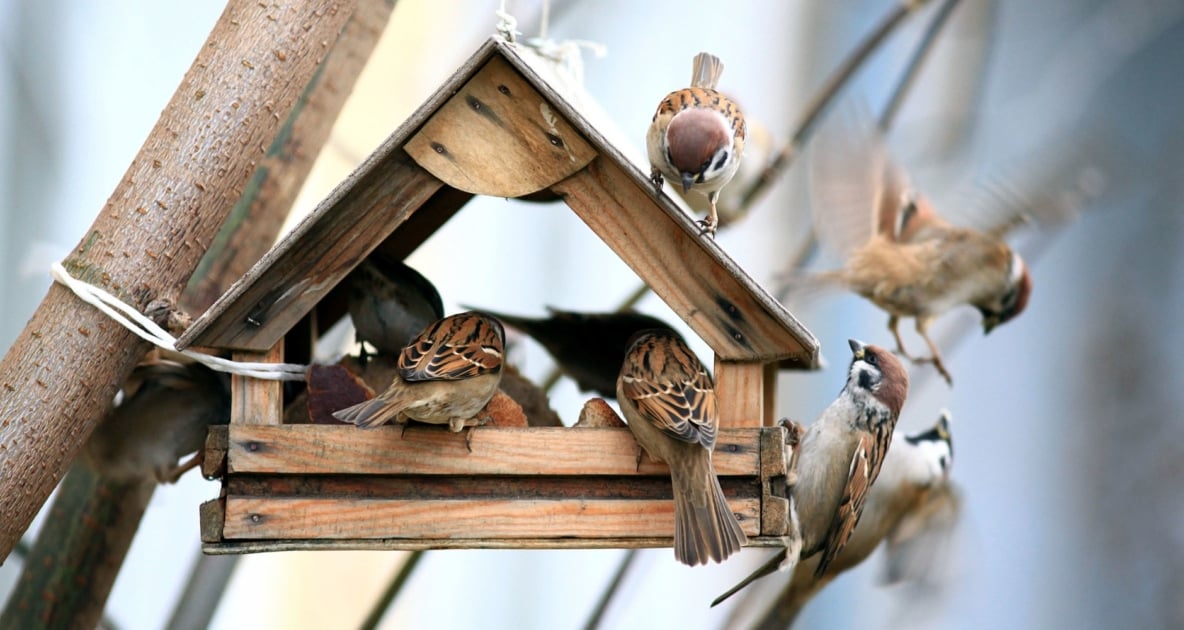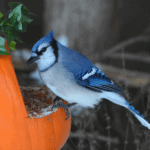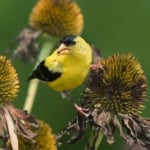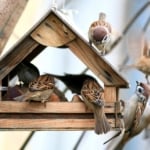6 Tips To Keep House Sparrows Away From Your Feeders
The house sparrow is considered an invasive bird in many areas, causing damage and problems for native species. So what can you do to discourage them from invading your back yard and feeders? We have a few helpful strategies.

House sparrows are familiar, widespread birds. They’re a common sight in cities and their chirping is a familiar sound, but they aren’t always the most welcome guests to birdhouses and feeders. The common house sparrow (Passer domesticus) is considered an invasive bird in many areas, causing damage and problems for native species. They will take over prime nesting sites, particularly from eastern bluebirds, tree swallows, and purple martins, and usurp feeders and overwhelm other visitors, including finches, tanagers, buntings, native sparrows, and Orioles, chasing them away, thus reducing backyard species diversity. This is exactly the opposite of most birders’ wishes, who often take great care to plan landscaping, choose feeders, offer nesting sites, and provide a varied diet to attract a greater range of birds. So what can you do to discourage house sparrows from invading your back yard and feeders? We have a few strategies.
Here’s how to identify house sparrows from native sparrows.
First, A Little History
Early American farmers imported the house sparrow with the promise these birds would keep crop-destroying pests under control. Unfortunately, they failed to do the proper research: these birds’ diet consists mostly of seeds and grains, not insects. Eventually, with all the plentiful food available, the house sparrow settled in wherever man settled (including cities and buildings), and began to depend on the food in our gardens to survive, removing the need to migrate.
Making House Sparrows Less Welcome
Many birders think the only way to get rid of them is to remove all food, water, and shelter from the yard, which will also discourage other birds from visiting. There are other ways, however, to continue nurturing other species while making house sparrows less welcome. To keep house sparrows away:
- Change Foods – House sparrows eat a wide range of seeds and grain, but they especially love cracked corn and sunflower seeds. Replace these treats with Nyjer or safflower seed, nuts, fruit, nectar, or suet instead, and while they may still sample the menu, they won’t gorge as much and other birds will have more opportunities to eat.
- Change Feeders – They are stocky birds that prefer to feed in large groups. They are most comfortable on broad platform feeders or feeding directly on the ground. Removing those feeding areas by switching to mesh or tube feeders with short perches (less than 5/8 of an inch) will give other birds plenty of feeding space while encouraging house sparrows to move elsewhere for their next meal. At the same time, clean underneath feeders regularly so spilled seed won’t tempt house sparrows to stick around.
- Offer More Food – It may seem counterintuitive, but offering more food in the yard can actually keep these birds from taking over feeders. Offer an open, convenient feeding area with plenty of cracked corn or other inexpensive seed to tempt house sparrows, and they will be more likely to take advantage of the easy meal instead of bothering more challenging feeders for the food they like less.
- Less Water – These birds love to bathe vigorously in shallow puddles and baths, but that takes away water from other thirsty birds. Instead of providing large bird baths that they will take advantage of, opt for misters or drippers that will provide moisture to birds without inviting splashy baths. Small hanging waterers are another option for offering water without giving house sparrows a spa.
- Less Dust – These birds enjoy dust baths almost as much as they enjoy splashing. Removing dry, dusty areas from your yard will discourage this behavior and urge house sparrows to find a different place to get down and dirty. Use thick mulch over landscaping beds to minimize open dusting areas and consider planting groundcovers or filling in thin turf to remove other dusting options.
- Remove Nesting Sites – These birds are cavity nesters and will easily adapt to nesting in any nooks and crannies they find, including dryer vents, chimney overhangs, or loose siding. Cover, plug, or repair these potential nesting sites to keep house sparrows out. Because sparrows start looking for nesting sites as early as February and March, don’t put out birdhouses until April 1, and later nesting birds will have more of a chance to find their perfect home without house sparrows’ interference. Birdhouses with entrances smaller than 1.25 inches in diameter will also keep house sparrows from taking up residence.
More Aggressive Options
Even when birders take all possible steps to make their property less welcoming to house sparrows, these adaptable birds can still be around, and it may be necessary to take more aggressive steps to remove them. As an invasive species in North America, house sparrows are not protected by federal or state laws, and it is legal to remove them with traps or other lethal methods. Before taking any aggressive action, however, birders should check local laws to be sure any methods they use are allowed in their community. It is also critical to be sure that no deterrent methods could accidentally impact any other bird species, pets, or other wildlife. If other birds, for example, are harmed by methods, birders could be subject to fines or other penalties for harming protected wildlife.
Even with many different options to keep house sparrows away, it can still be impossible to completely eliminate these birds from your property. Successful management is possible, however, and will reduce house sparrow populations and problems, allowing many other birds to enjoy your bird-friendly yard without house sparrow interference.

Melissa Mayntz
Melissa Mayntz is a writer who specializes in birds and birding, though her work spans a wide range—from folklore to healthy living. Her first book, Migration: Exploring the Remarkable Journeys of Birds was published in 2020. Mayntz also writes for National Wildlife Magazine and The Spruce. Find her at MelissaMayntz.com.






Saw this idea on a few YouTube bird-enthusiast channels and just slapped it together tonight. Took a well-used seed-catcher screen and sandwiched it between two pieces of wood, with hooks on both top and bottom sides. The evenly spaced original corded hooks dangle downward, giving some heft/weight. This serves, apparently, to repel the sparrows, as their eyesight is reportedly poor, and so dangling things like this tend to freak them out. One important note is that said strings/cords/fishing line/tape/etc. should be *longer* than the feeder itself (I’m using an 18-inch-or-so squirrel-proof tube feeder). Will report back on its efficacy post-deployment. Over & Out!
Sounds great! Let us know how it works!
I made a homemade “magic halo” by bending a large coated wire clothes hanger into a circle with the hook in the middle of the circle. I then hung 5 fishing lines on the circle with washers tied on the bottom of the fishing line so that the washers are hanging lower than the bird feeder. I put a little duct tape on either side of the fishing line attached to the coat hanger so that they wouldn’t slide around. I then hung it so it hangs over my feeder. It worked miraculously!! No sparrows at the feeder at all in a week. My goldfinches are fine eating at the feeder. If I can figure out a way to attach a picture, I will
Excellent topic, thanks.
Attract Grasshopper Sparrow Fast with These Simple Recipes
I have a shallow bird bath, the Sparrows don’t care, I have safflower and the eat as much of that as any other. I have suet and they gather around the little 5×5 suet feeder and peck away! I have platform feeders but don’t fill them most of the time. I quit feeding the sunflower all the time as the squirrels and sparrows eat it all. If I put out jelly of r Orioles, the Sparrows eat it. If I put out meal worms in the caged feeder with the dish, they come on in and eat the meal worms. They eat anything I put out. We even trapped them one year, but I have House Finch, Chipping Sparrows, White Throated sparrows and sometimes the White Crowned Sparrow. I sure don’t want any of them hurt. I have a little dirt but I can’t do all that just to keep them away. I did take all the feeders in for awhile but missed my other birds, so put them back. There is no way to solve this problem.
Hello. I use heavy fishing line tied to the top pf the feeder hanging down over the feeder. Use 6 or 8 double lengths so the line hangs down all around the feeder. It gives the sparrows the heebie jeebies and they don’t get to my feeder. Other birds just ignore it. Good luck.
Thank you, Mary and Bill, for your feedback! Best wishes from the team at FA.
Did the same. 100% effective.
can you show me a picture of this?
I would like to see a picture of that as well. I had planned to put my feeder back up this morning. Then suddenly sparrows flocked to my empty feeder.
Thank you for this article.